
The apple maggot, also known as the railroad worm, is a species of fruit fly, and a pest of several types of fruits, especially apples. This species evolved about 150 years ago through a sympatric shift from the native host hawthorn to the domesticated apple species Malus domestica in the northeastern United States. This fly is believed to have been accidentally spread to the western United States from the endemic eastern United States region through contaminated apples at multiple points throughout the 20th century. The apple maggot uses Batesian mimicry as a method of defense, with coloration resembling that of the forelegs and pedipalps of a jumping spider.

The Tephritidae are one of two fly families referred to as fruit flies, the other family being the Drosophilidae. The family Tephritidae does not include the biological model organisms of the genus Drosophila, which is often called the "common fruit fly". Nearly 5,000 described species of tephritid fruit fly are categorized in almost 500 genera of the Tephritidae. Description, recategorization, and genetic analyses are constantly changing the taxonomy of this family. To distinguish them from the Drosophilidae, the Tephritidae are sometimes called peacock flies, in reference to their elaborate and colorful markings. The name comes from the Greek τεφρος, tephros, meaning "ash grey". They are found in all the biogeographic realms.

The Tephritoidea are a superfamily of flies. It has over 7,800 species, the majority of them in family Tephritidae.
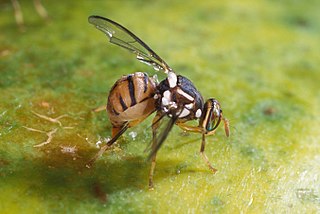
Bactrocera dorsalis, previously known as Dacus dorsalis and commonly referred to as the oriental fruit fly, is a species of tephritid fruit fly that is endemic to Southeast Asia. It is one of the major pest species in the genus Bactrocera with a broad host range of cultivated and wild fruits. Male B. dorsalis respond strongly to methyl eugenol, which is used to monitor and estimate populations, as well as to annihilate males as a form of pest control. They are also important pollinators and visitors of wild orchids, Bulbophyllum cheiri and Bulbophyllum vinaceum in Southeast Asia, which lure the flies using methyl eugenol.
Rhagoletis indifferens, the western cherry fruit fly, is a pest that lives only on cherries. Its native host is Prunus emarginata. The adult form of this insect is slightly smaller than a housefly, with white stripes across the abdomen, yellow markings near the base of the wings, and black markings on the wings. The larva, which is the stage of this insect's lifecycle that causes the actual damage to the fruit, is similar to a typical fly larva or maggot. Female flies lay eggs in the cherries, where the larvae feed for 1–2 weeks before exiting. Western cherry fruit flies damage fruit by feeding, in both the adult and larval stages.

Rhagoletis mendax is a species of tephritid fruit fly known by the common name blueberry maggot. The blueberry maggot is closely related to the apple maggot, a larger fruit fly in the same genus. It is a major pest of plant species in the Ericaceae family, such as blueberry, cranberry, and huckleberry. The larva is 5 to 8 mm long, apodous, and white with chewing mouthparts. Female adults are 4.75 mm in length, males are slightly smaller. Both adults are mostly black in color with white stripes, orange-red eyes, and a single pair of clear wings with black banding. The adult female fly lays a single egg per blueberry, and when the larva hatches it consumes the fruit, usually finishing the entire berry in under 3 weeks and rendering it unmarketable. The larva then falls to the soil and pupates. Adult flies emerge, mate, and females oviposit when blueberry plants are producing fruit. Each female fly can lay 25 to 100 eggs in their lifetime.
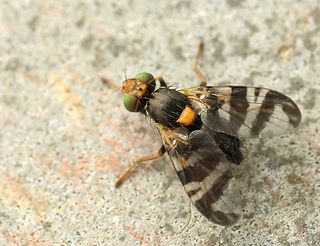
Rhagoletis cerasi is a species of fruit fly in the family Tephritidae.

Strauzia longipennis is a large species of tephritid fruit fly known by the common name sunflower maggot. It is a minor pest whose larvae mine stems of sunflowers. Damage from larval feeding on spongy tissue is usually light. The larvae do not damage the flower head or seeds, although those of other fruit fly species do so.
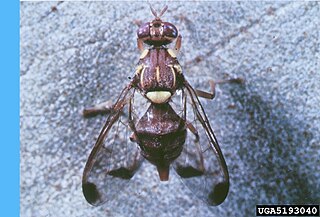
Bactrocera cucurbitae, the melon fly, is a fruit fly of the family Tephritidae. It is a serious agricultural pest, particularly in Hawaii.

Euleia heraclei, known as the celery fly or the hogweed picture-wing fly is a species of tephritid or fruit flies in the genus Euleia of the family Tephritidae.
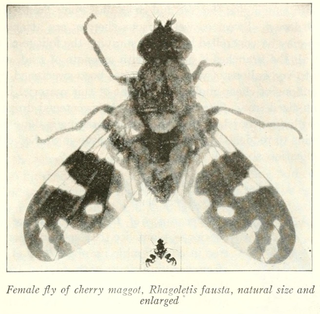
Rhagoletis fausta, the black-bodied cherry fruit fly, is a species of tephritid or fruit flies in the genus Rhagoletis of the family Tephritidae. It is found in the United States and Canada.
Rhagoletis juglandis, also known as the walnut husk fly, is a species of tephritid or fruit fly in the family Tephritidae. It is closely related to the walnut husk maggot Rhagoletis suavis. This species of fly belongs to the R. suavis group, which has a natural history consistent with allopatric speciation. The flies belonging to this group are morphologically distinguishable.

Goniglossum wiedemanni is a species of tephritid or fruit flies in the family Tephritidae, and the only species in the genus Goniglossum.
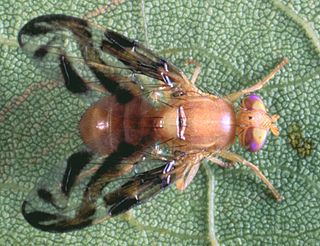
Anastrepha suspensa, known as the Caribbean fruit fly, the Greater Antillean fruit fly, guava fruit fly, or the Caribfly, is a species of tephritid fruit fly. As the names suggest, these flies feed on and develop in a variety of fruits, primarily in the Caribbean. They mainly infest mature to overripe fruits. While thought to have originated in Cuba, the Caribbean fruit fly can now also be found in Florida, Hispaniola, and Puerto Rico.
Ceratitis rosa, or commonly known as the natal fruit fly, is a fruit fly species from the family Tephritidae of the order Diptera. It is considered a pest in both its native and non-native habitats. It prefers subtropical or temperate climates and the fruits that are native to these areas. It is also capable of surviving in less dry climates compared to its relative, the Ceratitis capitata which is more specific in its habitats, described by Anton Ferdinand Karsch in 1887 in Delagoa Bay, Mozambique. Not long after in 1900, the natal fruit fly was a recognized pest for orchards and fruit farmers throughout KwaZulu Natal Province, Republic of South Africa.

Terellia tussilaginis, the gall fly, is a species of tephritid or fruit flies in the family Tephritidae.

Bactrocera carambolae, also known as the carambola fruit fly, is a fruit fly species in the family Tephritidae, and is native to Asia. This species was described by Drew and Hancock in 1994.

Anastrepha fraterculus, known as the South American fruit fly, is a fruit fly species from the genus Anastrepha. A. fraterculus is a polyphagous, frugivorous fly that is a significant pest of commercial fruit production in South America.

Oxycera meigenii is a species of soldier fly in the family Stratiomyidae.

















